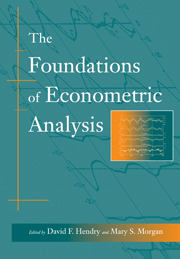Book contents
- Frontmatter
- Contents
- Preface
- Acknowledgements
- Introduction
- Bibliography
- I The Emerging Role of Econometrics in Economics
- II Early Time-Series Analysis
- 6 On the Study of Periodic Commercial Fluctuations (Read to the British Association in 1862, and in Investigations in Currency and Finance, Macmillan, 1884, pp. 3–10 and plates)
- 7 Correlation of the Marriage-Rate with Trade (Journal of the Royal Statistical Society, vol. 64, 1901, pp. 485–92)
- 8 The Correlation of Economic Statistics (Journal of the American Statistical Association, vol. 12, 1910, pp. 289–94, 306–17 (cut))
- 9 Why do we sometimes get Nonsense Correlations between Time-Series? (Journal of the Royal Statistical Society, vol. 89, 1926, pp. 2–9, 30–41)
- 10 On a Method of Investigating Periodicities in Disturbed Series, with Special Reference to Wolfer's Sunspot Numbers (Philosophical Transactions of the Royal Society of London, A, vol. 226, 1927, pp. 267–73)
- 11 A Random-Difference Series for Use in the Analysis of Time Series (Journal of the American Statistical Association, vol. 29,934, pp. 11–24 (data cut))
- 12 Calculation and Elimination of Seasonal Fluctuations [Berechnung und Ausschaltung von Saisonschwankungen] (Julius Springer, Vienna, 1936, chap. 1)
- 13 Morgenstern on the Methodology of Economic Forecasting (Journal of Political Economy, vol. 37, 1929, pp. 312–17, 320–3, 326–37 (cut))
- III Applied Econometrics and the Identification Problem
- IV The Evolution of Statistical Thinking in Econometrics
- V Dynamic Models
- VI The Tinbergen Debate
- VII Structure and Simultaneity
- VIII The Probabilistic Revolution
- IX Exogeneity
- Index
13 - Morgenstern on the Methodology of Economic Forecasting (Journal of Political Economy, vol. 37, 1929, pp. 312–17, 320–3, 326–37 (cut))
Published online by Cambridge University Press: 05 June 2012
- Frontmatter
- Contents
- Preface
- Acknowledgements
- Introduction
- Bibliography
- I The Emerging Role of Econometrics in Economics
- II Early Time-Series Analysis
- 6 On the Study of Periodic Commercial Fluctuations (Read to the British Association in 1862, and in Investigations in Currency and Finance, Macmillan, 1884, pp. 3–10 and plates)
- 7 Correlation of the Marriage-Rate with Trade (Journal of the Royal Statistical Society, vol. 64, 1901, pp. 485–92)
- 8 The Correlation of Economic Statistics (Journal of the American Statistical Association, vol. 12, 1910, pp. 289–94, 306–17 (cut))
- 9 Why do we sometimes get Nonsense Correlations between Time-Series? (Journal of the Royal Statistical Society, vol. 89, 1926, pp. 2–9, 30–41)
- 10 On a Method of Investigating Periodicities in Disturbed Series, with Special Reference to Wolfer's Sunspot Numbers (Philosophical Transactions of the Royal Society of London, A, vol. 226, 1927, pp. 267–73)
- 11 A Random-Difference Series for Use in the Analysis of Time Series (Journal of the American Statistical Association, vol. 29,934, pp. 11–24 (data cut))
- 12 Calculation and Elimination of Seasonal Fluctuations [Berechnung und Ausschaltung von Saisonschwankungen] (Julius Springer, Vienna, 1936, chap. 1)
- 13 Morgenstern on the Methodology of Economic Forecasting (Journal of Political Economy, vol. 37, 1929, pp. 312–17, 320–3, 326–37 (cut))
- III Applied Econometrics and the Identification Problem
- IV The Evolution of Statistical Thinking in Econometrics
- V Dynamic Models
- VI The Tinbergen Debate
- VII Structure and Simultaneity
- VIII The Probabilistic Revolution
- IX Exogeneity
- Index
Summary
This is one of those rare books which, if only they are received with the serious attention that they deserve, sometimes succeed in forcing an entirely new orientation in the field of scientific endeavour with which they deal. The book would deserve the closest attention, even if its specific arguments were found to be either unsound or of little permanent value for further research along positive lines, by virtue of the vision of its conception, the saneness with which it sets limits to the discussion, and the boldness with which it states its conclusions. It required an imaginative vision to pull one's self consciously away from the details both of present methods of ‘business forecasting’ and of the ‘cycle theories’ which, consciously or unconsciously, lie at the base of those methods, in order to examine the methodological assumptions common to all methods and theories. It required a saving sense of balance to prevent the inevitably abstract and formal nature of the treatment from leading to fruitless juggling with metaphysical subtleties of doubtful relevance. It required courage of high order to issue a challenge, couched in the most uncompromising terms, to the vested interests represented by those ‘Institutes’, commercial and ‘scientific’, which are at this moment devoting a huge expenditure, in time and effort, to the study of business forecasting.
- Type
- Chapter
- Information
- The Foundations of Econometric Analysis , pp. 180 - 190Publisher: Cambridge University PressPrint publication year: 1995

